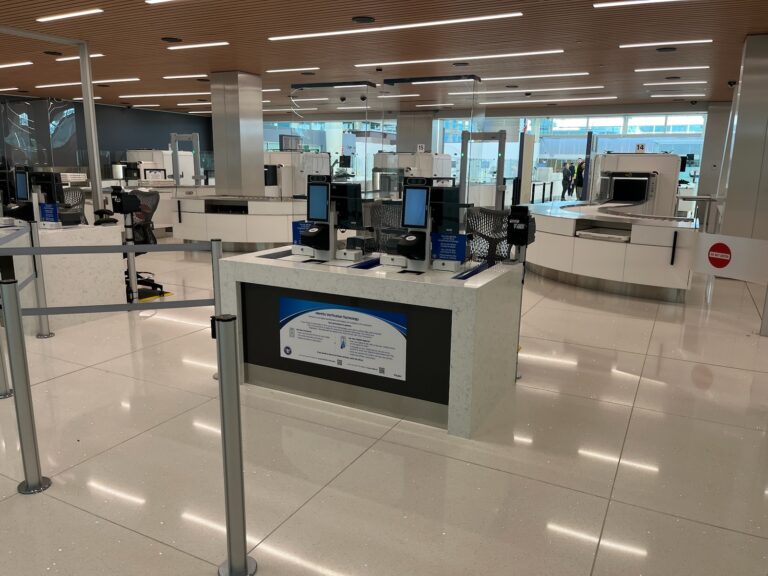On February 5, officials from Denver International Airport (DEN) and the Transportation Security Administration (TSA) previewed the new West Security Checkpoint on Level 6 of the airport terminal. The checkpoint will feature 17 lanes to screen departing travelers and will replace the North Security Checkpoint.
The new checkpoint brings the total number of security screening lanes at the airport to a maximum of 44. TSA will continue to screen travelers at the South Security Checkpoint as well as at the A-Bridge checkpoint. At DEN, all security checkpoints lead to all gates.
The West Security Checkpoint has three entrances. Electronic signage will direct travelers to the correct entrance based on the type of screening they are eligible for while also providing travel advice and information.
Travelers will see some new security technologies in use when being screened through the new checkpoint.
Next-generation credential authentication technology
Travelers will encounter the latest version of Credential Authentication Technology (CAT-2) during the travel document verification process. The units are equipped with digital ID readers and a camera that captures a real-time photo of the traveler. CAT-2 compares the traveler’s photo on the government-issued ID against the in-person, real-time photo. Once the unit confirms a match, a TSA officer verifies it and the traveler can proceed to security screening. TSA officers can perform additional passenger verification if needed. Through a secure internet connection, the units also verify that an individual is ticketed for air travel, negating the need to show a boarding pass.
TSA reminds travelers that photos captured by a CAT-2 unit are never stored or used for any other purpose than immediate identity verification. Travelers who do not wish to participate in the facial matching process can opt out in favor of an alternative identity verification process. There are 34 CAT-2 units installed in the West Security Checkpoint to conduct identity verification of travelers.
Automatic screening lanes
The new checkpoint features 17 automated screening lanes (ASLs) that are designed to improve the screening of travelers by automating many of the checkpoint functions that were previously performed manually. The ASLs allow travelers to move more quickly and efficiently through the security checkpoint. The ASL technology includes:
- Individual, side-by-side, stainless-steel stations that enable three travelers to place their carry-on property in bins; all carry-on property must be placed in a bin;
- Bins that are 25% larger than standard screening lane bins and big enough to hold larger carry-on bags;
- Automated conveyor belts that populate bins for travelers to use and subsequently return the bins from the back of the checkpoint to the front;
- Automatic diversion of carry-on property that may contain a potential security threat, allowing bins behind to continue through the screening process uninterrupted;
- Radio frequency identification (RFID) tags that are attached to each bin to allow for additional accountability of a traveler’s carry-on property as they move through the security process.
Computed tomography units
The checkpoint is fully outfitted with the latest x-ray technology to screen travelers’ carry-on property. The x-ray units use computed tomography (CT) to generate a 3D image of the contents of the carry-on, providing advanced explosive detection capabilities.
A TSA officer can view and rotate the x-ray image on-screen for thorough visual image analysis. By getting a better view of the contents of the bag, the TSA officer can resolve potential security threats on-screen, ultimately reducing the number of bag checks that are required.
When a carry-on bag is screened through a CT scanner, travelers can leave everything in their carry-on bag, including electronics larger than a cell phone and travel-size liquids. Every item screened through a CT scanner system must be placed in a bin for screening.
Passenger screening technologies
The West Security Checkpoint has nine eAIT body scanners to screen individual travelers for potential security threats. The eAIT body scanner is a flat-panel, open-design body scanner that uses millimeter wave technology, which can detect metallic and non-metallic objects that may be concealed in layers of clothing or on the body. During the scan, travelers keep their hands at their sides rather than holding them over their heads.
The eAIT unit also provides corrective feedback to the TSA officer before scanning. This reduces incorrect positioning of the traveler and thus the need to be rescanned. It also allows TSA officers to conduct follow-up screenings of multiple travelers simultaneously when needed, increasing the efficiency of the screening process.
Because the eAIT is not a metal detector, many travelers, including those with metal hips or knee replacements, prefer to be screened by it. In addition, the body scanner does not use x-ray technology and it does not generate x-ray or specific images of any traveler.
Bottle liquid scanners
TSA allows travelers to bring medically necessary liquids in carry-on luggage in quantities larger than 100ml. To ensure that these items do not pose a security threat, TSA uses a liquid explosive detection system, which uses lasers to measure the density of the liquid without having to open the container. This type of screening takes seconds and can be used to screen both liquids and gels.
Explosive trace detection screening
TSA officers may conduct explosive trace detection (ETD) screening that involves a swab of a traveler’s hands or their belongings at the security checkpoint. The swab is inserted into a specially programmed ETD unit that can detect even the smallest amount of explosive residue. TSA has a process in place to resolve any alarms related to the detection of explosive residue.
TSA screened more than 23.5 million departing travelers at DEN in 2023, making it the 11th-busiest airport for TSA security checkpoint screening operations.
Completion of the West Security Checkpoint is part of a US$1.3bn ongoing construction project at DEN. The entire project, which will include a companion East Security Checkpoint, is expected to be completed in late 2027.
For more security news, please click here.

